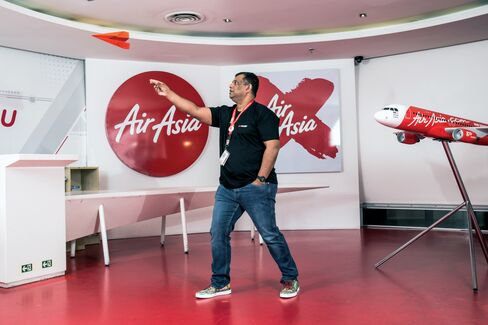AirAsia CEO: ‘We Need to Get Our Ass Kicked’
Tan KW
Publish date: Fri, 05 Aug 2016, 10:39 AM
Tony Fernandes sees huge potential in a region where discount air travel is still a novelty.
The following is a condensed and edited interview with Tony Fernandes, CEO, AirAsia Group.
When you were a kid in Kuala Lumpur, what did you want to be when you grew up?
I wanted to own an airline. I said that to my father. He said, “You make it past the doorman at the Hilton Hotel, I will be pleased.” Those were the exact words. I still remember that.
What motivated you to enter the business?
I saw Ryanair and EasyJet—it was a no-brainer. If I could bring the low-fare product here to Asia, why not? I always say there’s a fine line between brilliance and stupidity. But to me it was an unbeatable product to make travel cheaper. There was one statistic that stuck in my mind when I started doing research: Only 6 percent of Malaysians flew. So I thought I had a 94 percent market.

You’d already worked for Richard Branson at Virgin Communications and at Warner Music.
I felt that, because I was 34 at the time, if I failed I will go back and get another job. But I didn’t want to sit at 55 and say I wish I had tried. It was a time in life where if I left Warner and took the next job, I would have been stuck in corporate life forever. I thought if I failed, I failed.
So in December 2001, you suddenly bought this company for 1 ringgit (25¢) and took over all those debts. Did you ever see yourself as kind of an Uber of airlines?
That’s great. I hope someone asks Travis [Kalanick, Uber’s CEO] if he is the AirAsia of taxis. I am going to tell him that.
We certainly disrupted air travel to a massive extent. It was cozy duopolies and monopolies. It was expensive. It was giving a service to a small part of the population. Then we came along and disrupted it, and then others came and followed us in the process. That has made traveling and air flights much more accessible.
But we’ve only scratched the surface. There’s so much more growth that can happen in this part of the world.
How so?
You only have to compare the number of aircraft you have in Europe with the number of aircraft in Asia. It’s tiny. If you take out China, it’s super tiny. You can’t drive from one part of Asia to the other. You can in Europe. The potential to grow in this part of the market is huge.
You know, we flew to Shantou the other day. When I was asked to fly there by the head of Guangdong airport, I said, “Where is that?” And he told me the population is 8 million, and I said, “We will fly there.” And we are full.
Eventually, how big can the airline business get here?
In Asia, there’s no reason why an airline can’t have 500 to 1,000 aircraft, really, if you include China and India.
There’s only one Asian airline with 500 planes today, China Southern.
Correct. But if you look at Europe, there are five or six airlines with 500 aircraft. And we are a much bigger playground than them. So what I am trying to highlight is that we have only just begun.
Now that your low-fare success story is so public here in Asia, that’s inspired a lot of competitors to come in.
If someone is better than us and we get our ass kicked, then we need to get our ass kicked. Competition is the best form of motivation, the best form of becoming better, and I like competition. It keeps me hungry, keeps me going.
Is anyone kicking your ass?
Yeah, Lion [Air] kicks our ass in Indonesia, and we’ve gotten better and learned. I think, Cebu [Air] does a good job in the Philippines. No one is able to do what we’ve managed, which is build a pan-Asian model, but that will come surely. My idea wasn’t a new idea. I learned it from [Southwest Airlines founder] Herb Kelleher, [Ryanair CEO] Michael O’Leary, and Stelios [Haji-Ioannou, EasyJet’s founder]. So no one is exclusive to any ideas.
Your long-term vision is to be Asia’s biggest low-cost carrier. How far into that are you?
We are certainly now Asia’s largest discount carrier. We stretch from India to Japan—we are the only airline that has the breadth of coverage. We are in the domestic market in India, we are in five other domestic markets, we are very deep into China. So I’d say our vision is maybe 30 percent to 40 percent of where we can eventually be.
There are more women pushing soda carts in airplanes than there are flying them. You’ve made some efforts, but what more can be done?
Most of our top managers are women. I think there’s a 50-50 mix already. I think that’s a big success for an Asian company. As an organization, male and female is not discussed—we don’t even think twice—it’s a meritocracy. And airlines such as ours have inspired others to go and do it. So you see more airlines talking about it.
What’s holding them back?
Social pressures. There is discrimination for sure. When I first mentioned to my chief pilot about having females as pilots, I can’t even repeat to you what he said. There’s old-fashioned feelings in there, but it’s breaking down now.
http://www.bloomberg.com/news/articles/2016-08-04/airasia-ceo-we-need-to-get-our-ass-kicked
Related Stocks
| Chart | Stock Name | Last | Change | Volume |
|---|
More articles on Good Articles to Share
Created by Tan KW | Jan 10, 2025
Created by Tan KW | Jan 10, 2025
























RenegadeMaster
Say what you want about Tony, the man has vision.
2016-08-05 12:23